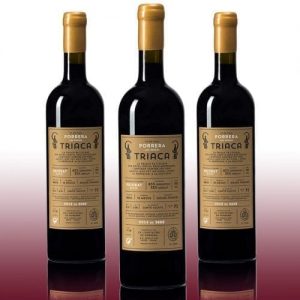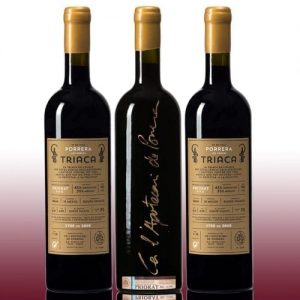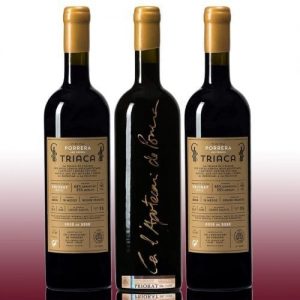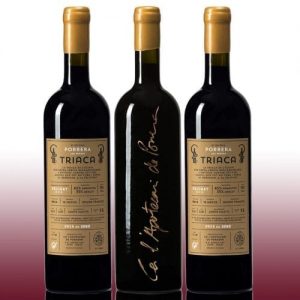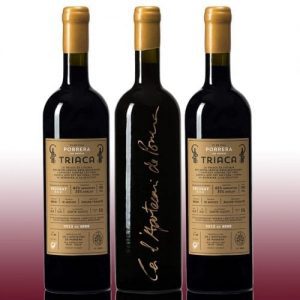18 Feb The History of Triaca Red Wine from Ca l’Apotecari de Porrera Vineyard – Santi Puig
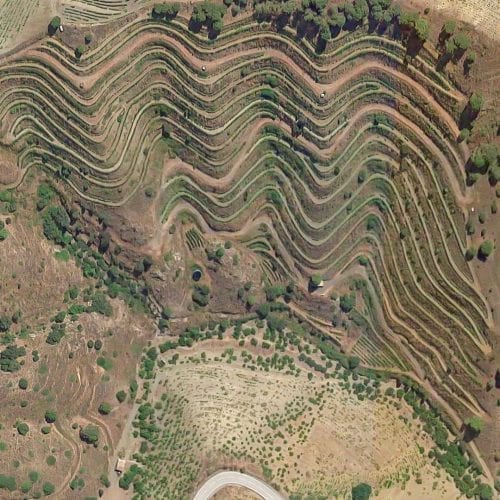
The Story behind the Vineyard Ca l’Apotecari de Porrera, Red Wine Triaca and its owner Santi Puig
It all started with the great-uncle of ‘Santi’, Santi’s grandfather’s brother, Jaume, was Porrera’s last ‘Apotecari’. Although he has been dead for a long time, during the outbreak of the Spanish civil war, Santi (the current owner and winemaker) only took over the ‘Uncle Jaume’ plots at the beginning of the century. These plots are called: ‘Los Perers’ and ‘Les Eres’.
Los Perers’ is between 400 and 500 meters of altitude oriented to the northwest with a very abrupt configuration that had to be adapted in terraces to facilitate the work of the Vineyard with better water retention. These abrupt profiles and the Licorella soils are what makes Priorat such a characteristic wine. The land is made up of a very thin layer of earth on imposing shale formations that force the plants to pierce them with their roots. This will provide them with the necessary water resources when apparently there are no more. Very few nutrients are found at this depth.
It was updated in 2000 with new plants of four varieties and very low-yielding clones: Garnacha, Cariñena, Cabernet Sauvignon, and Merlot. The lack of nutrients, added to the low-yield characteristics of the clones, produces between 500 and 700 grams of an extraordinary grape per plant. The Grenache is planted on the upper terraces, which favors a clean and well-ventilated environment so that the grapes can ripen without diseases. The Merlot is located in a lower corner and with little insolation that adapts very well to its early maturation.
The Project
The objective they have is to make a very select wine in small quantities that is comparable to the ‘Garagistes‘ or the ‘Supertuscans‘. As the ‘Wine, they make in the Vineyard’, they pay great attention to agricultural practices, fully compatible with ecological standards, and allow, to some extent, the interaction of adventitious plants (Santi refuses to call them’ Bad Herbs’ ) that enrich the flavor and aromas of the wine.
The increasingly hot summers have raised the challenge of preserving the freshness and primary aromas in wines made with grapes from warm vineyards such as those of Priorat. In this sense, Los Perers offers a clear advantage with its northwest orientation. The secret of real freshness in these conditions is based on viticultural practices such as preserving the leaves that protect the grape from excessive sunlight or the sprouting of the plants to concentrate its resources on the ripening of the fruit, thus achieving a much better balance between organoleptic maturity and acidity, that is, freshness. ‘Les Eres’ is intended for white sweethearts, with its floral magic, but will still have to pass a certain time to obtain a quality product.
After more than a decade of experimenting at the Ca l ’Apotecari Winery, Santi decided that he was ripe to launch his first wine.

Santi Puig the winemaker with a lot of fun in action on his tractor
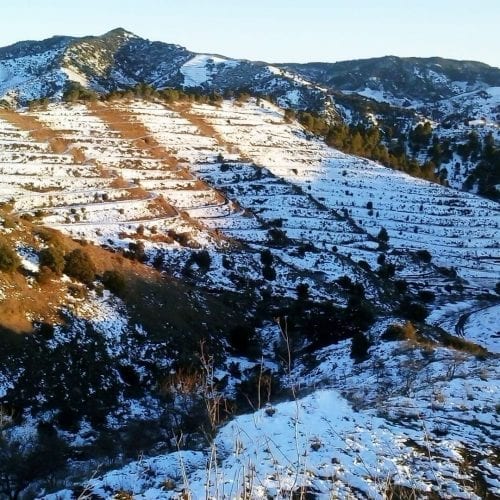
Winters are not as mild as you might think …
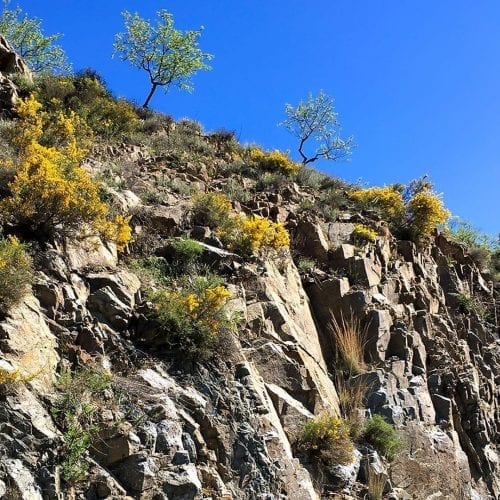
There is only a very thin layer of soil on top of the bedrock

The strains sink their roots into the rock to access the few nutrients they can collect
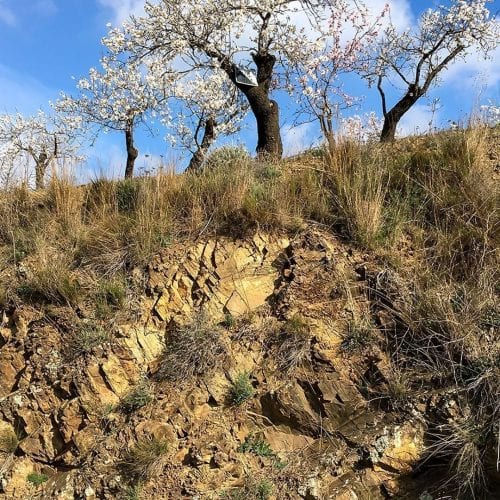
But spring always ends up coming

The old log begins to sprout …
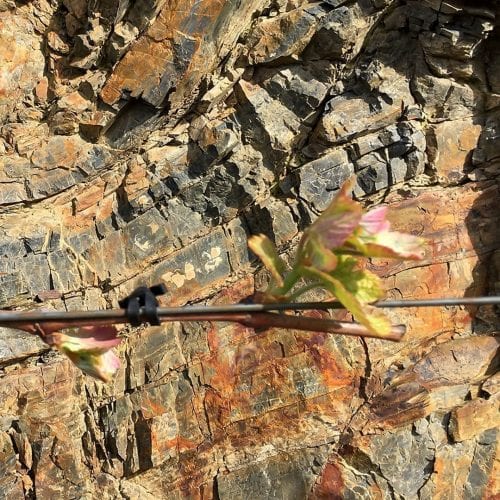
…and the not so old!
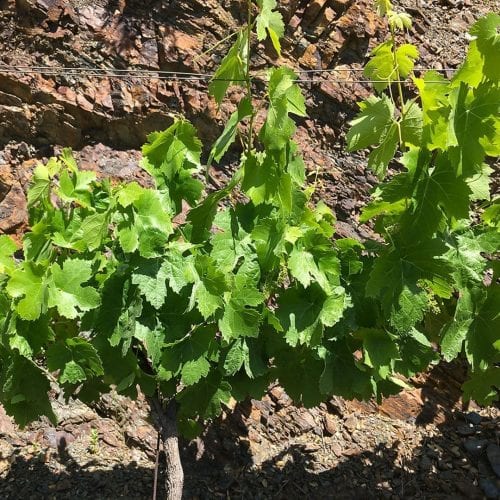
Eventually, new foliage grows against all odds…
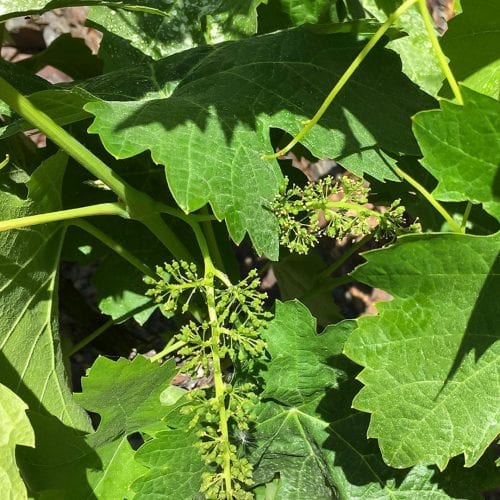
…and flowering takes place
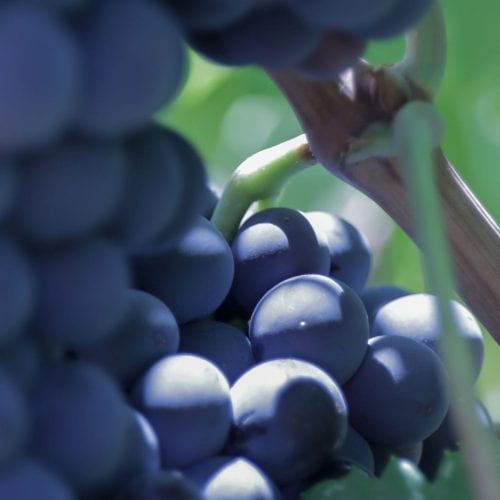
The generous results make it all worthwhile
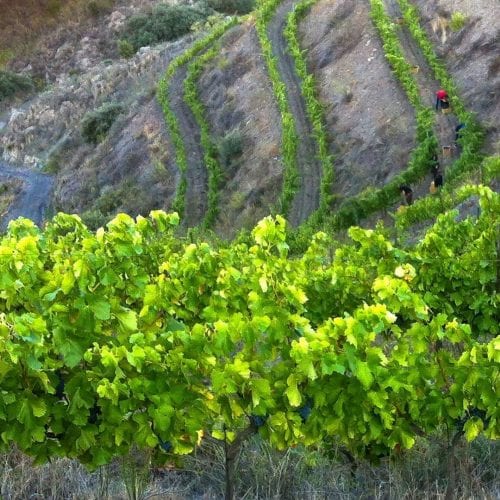
Harvest time is coming…
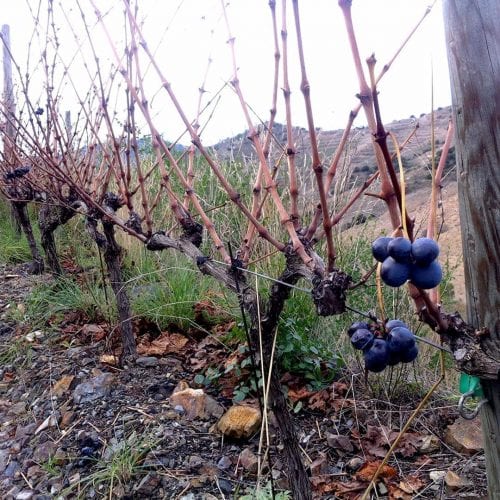
Just to make way for another fall
‘Making wine is an extremely slow thing’
The first red wine launched was the Triaca of 2013
Triaca, or also Panacea for connoisseurs, is the elixir that apothecaries prepared to preserve health and well-being in general amde at the Vinyard Ca l’Apotecari de Porrera.
The starting year 2013 was an extraordinary vintage in Priorat, as stated by Robert Parker in his table of vintages. It was the perfect time for Santi to embark on the development of Triaca with the idea that had been macerating and taking shape for so long.
The characteristics of the resulting wine had been perfected in many successive experiments and passionate tuning trials that Santi had dedicated to it during all these years in the ‘Ca l’Apotecari’ winery.
How is Triaca made?
The vineyard is run by ecological standards, although it is not certified.
The harvest date is decided based on three variables: sugar level, acidity, and phenolic maturity. The first and second parameters are determined by chemical and physical analysis techniques, but the third is established by organoleptic means (with the help of wild boars, a very demanding animal). The grapes are harvested in the early hours of the day and taken to the winery. There it is refrigerated overnight, the next day it is skidded and placed in a stainless steel tank, also refrigerated, to do what is called cold maceration.
A couple of days later, the refrigeration is turned off, to allow the berries to slowly begin to ferment with their own yeasts. During the next three weeks, the fermentation temperature remains significantly low. Once this is completed, the skins are left to marinate for a week or two more before the pasta is drained and pressed. Santi only incorporates a small amount of pressed wine into the final wine to guarantee a sufficient level of tannins to facilitate aging. The coupage is made before malolactic fermentation.
The ‘Malo’ (Bad), as it is colloquially called, takes place in the aging barrels deep within the cellar. These barrels are made of French oak, but not too new, since Santi does not want the smoky aromas of the wood to dominate. There he will stay for more than a year and a half.
After this time, the wine is returned to a refrigerated tank to promote any residual precipitation before being bottled. This last stabilization process is done exclusively by means of the cold (often the weather helps) while the wine is subjected to a tasting panel of the DOQ Priorat Regulatory Council that must guarantee its quality and, if approved, award it the label. of the DOQ. Subsequently, the bottles are kept in the cellar for another year and a half to allow the last maturation before going out on the street.
How does the Red Wine Triaca DOQ Priorat taste?
Despite the fact that the word ‘minerality’ is very controversial, Santi cannot find a better word to define what it is that makes Priorat wines so characteristic. If you visit Priorat, drink water from the ‘Minas’ of the Vineyards, which will give you an exact definition of what this word means in wine. Priorat wines are also a cluster of aromas and smell with tannins tamed by time and alcohol that articulates the whole, rounding it out. It is for this reason that these wines require such long maturation times.
Triaca is a typical Priorat wine with an outstanding characteristic: Its Freshness
Triaca is a typical Priorat, but with a characteristic that makes it unique: its freshness. The objective we pursue, both in the vineyards and in the winery, is to preserve this penetrating acidity that makes the wine open in your glass, releasing wave after wave of aromas, among which we would highlight, surprisingly, that of fresh fruit.
Santi personally prefers to avoid decanting and let the wine open itself in the glass to be able to ‘contemplate’ the transformations that take place. Santi says that he would never tire of this show and it seems to me that neither do we. Somehow it is like walking with your eyes closed through the landscape of the region, stumbling over stumps of fennel or brambles, while listening to the struggling races of the partridges as they take flight and the hissing trajectories of the lizards, with waves of rosemary and thyme entwined with these sounds.
Santi will never make you a long list of the use of aromas of red fruits and others. It tastes bad to me, but what Santi tells us that he feels in a glass of Triaca is the earth under his feet, populated by an infinity of life forms, the sky above his head, also inhabited by a large number of animals and vines linking the two universes, the underground one with that of air and light.
In the words of Santi: ‘It’s infinitude in a single glass’
The ingredients of the Red Wine Vinyard Ca l’Apotecari de Porrera made?
Made exclusively with grapes grown under organic standards in our ‘Los Perers’ vineyard, with extremely rocky shale soils called ‘Licorella’. In dry land and without irrigation. Manual harvest in the early hours of the day. Selection both in the field and in the winery. Refrigeration of the grapes until the next day. Destemming with minimal damage to the berries and cold maceration for two days. Spontaneous fermentation in stainless steel tanks at a relatively low temperature (22º) and subsequent maceration in the same tank. The malolactic fermentation takes place in the aging barrels. After a year and a half of ‘retirement’, the wine returns to a refrigerated tank for stabilization while DOQ tasters verify that it is of sufficient quality to be qualified as such.
How it’s bottled?
The wine is bottled unfiltered and there is a limited production: in 2013 there were 4,095 bottles, in 2014 there were 3,885 bottles, in 2015 3,800 bottles and, finally, 3,800 bottles of 2016. A minimum of 18 months of aging is carried out in a bottle. before launch.
How does it Taste?
Dark ruby color with little variation in the rim. The great explosion of fresh red fruit, light notes of slate, minor herbaceous aromas. Creamy notes of oak, although generally integrated. Alcohol somewhat pronounced initially on the nose, but well balanced. The most prominent red fruit on the palate. Surprisingly light, though overall it betrays the low tones of the Priorat. Rather dry tannins that last.
Technical sheet
- Appellation: D.O.Q. Priorat
- Type of wine: Red Wine aged in barrels
- Varieties: 65% Grenache; 35% Merlot
- Alcohol grade: 16% vol.
- Vineyard origin: Los Perers, Porrera, Tarragona, Spain
- Age of vineyard: planted in 2002
- Winemaking: The traditional method
- Harvest grape: September – October
- Spontaneous fermentation: Maceration for 29 days
- Aging: 18 months in French Oak barrels
- Bottle: Bordelaise 75 cl.
- Stopper: natural cork (45×24 mm.)
- Capsule: 100% wax
Location of the Vinyards Ca l’Apotecari de Porrera ‘Los Perers’ and ‘Les Eres’
Now that you know the story behind ‘Ca l’Apotecari’ de Porrera and its vineyards, it’s time to try out the Exclusive Limited Edition of these great wines.
We have the honor to offer the Triaca ‘Priorat’ of the years 2013, 2014, 2015 in 1 package being a set of 3 bottles.
Try the ‘Vertical Taste’ now!
You can also choose to order separately each year for the years 2013, 2014, 2015, and the newly bottled 2016 (minimum order 3 bottles).
Click Here and Choose, we Guarantee You a Sublime Experience
-
Red Wine Vertical Tasting Triaca Priorat 2013, 2014, 2015 – D.O.Q Priorat – Ca l’Apotecari de Porrera – Grenache, Merlot
€105 -
Red Wine Triaca Priorat 2016 – D.O.Q Priorat – Ca l’Apotecari de Porrera – Grenache, Merlot – Edition 3.800
€35 -
Red Wine Triaca Priorat 2015 – D.O.Q Priorat – Ca l’Apotecari de Porrera – Grenache, Merlot – Edition 3.335
€35 -
Red Wine Triaca Priorat 2014 – D.O.Q Priorat – Ca l’Apotecari de Porrera – Grenache, Merlot – Edition 3.885
€35 -
Red Wine Triaca Priorat 2013 – D.O.Q Priorat – Ca l’Apotecari de Porrera – Grenache, Merlot – Edition 4.095
€35
